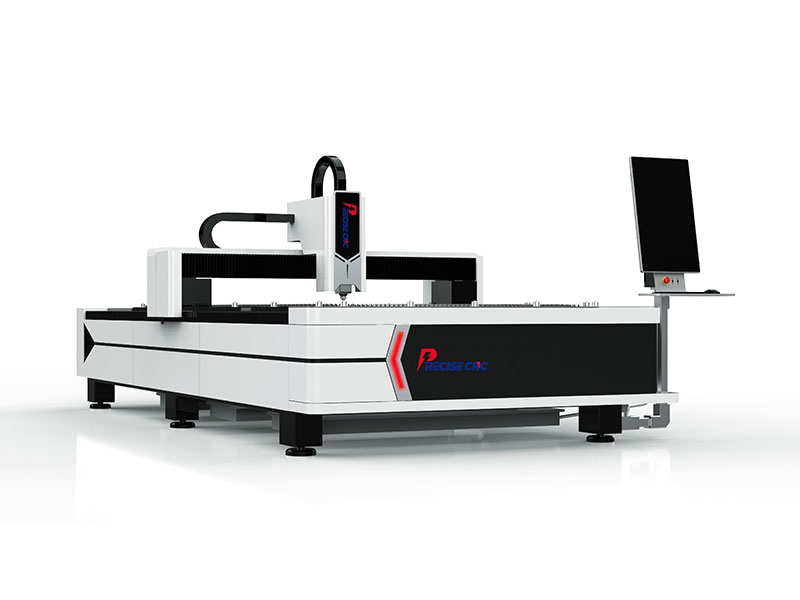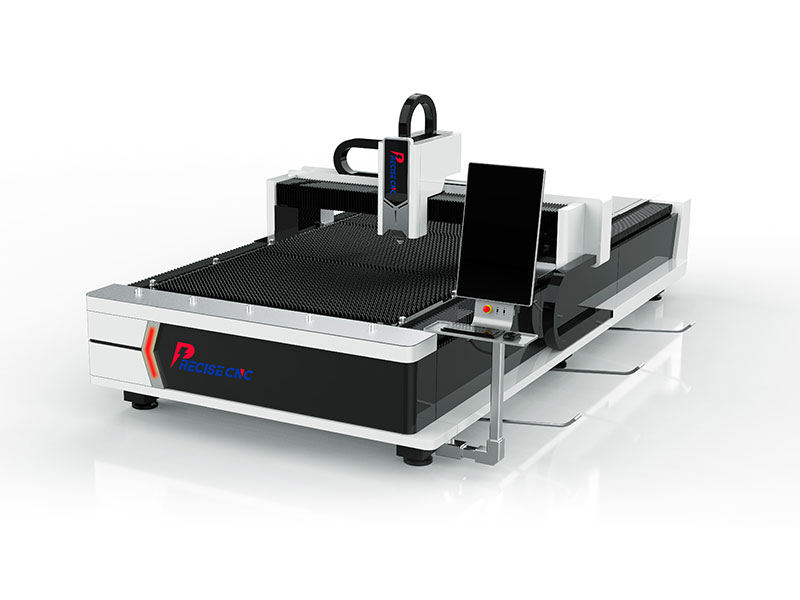In the manufacturing and fabrication industries, laser cutting machines have become indispensable tools, valued for their precision, efficiency, and versatility. However, to select the right equipment for your needs, understanding technical specifications and key features is critical. This article breaks down the essential parameters, functionalities, installation processes, and maintenance requirements of laser cutting machines, helping you make informed decisions. At the end, we’ll also highlight why Jinan Precise CNC Equipment Co., Ltd. stands out as a trusted provider of industrial-grade laser solutions.

Technical Specifications: The Foundation of Performance
Technical specifications define a laser cutting machine’s capabilities, from material compatibility to cutting precision. Below are the core parameters to evaluate:
1. Laser Type: Matching Lasers to Materials
The type of laser determines which materials a machine can process. Two primary technologies dominate the market:
CO₂ Lasers: Ideal for non-metal materials such as wood, acrylic, fabric, paper, and plastics. They use a gas mixture (typically CO₂, nitrogen, and helium) to generate a 10.6μm wavelength laser, which is highly absorbed by organic materials.
Fiber Lasers: Designed for metal cutting, including stainless steel, aluminum, brass, and copper. They utilize fiber optic cables to amplify laser light, delivering a shorter wavelength (1.06μm) that achieves superior precision and energy efficiency for metallic surfaces.
Example Applications: CO₂ lasers are common in signage and textile industries, while fiber lasers excel in automotive part manufacturing and metal fabrication.
2. Laser Power: Balancing Thickness and Speed
Laser power, measured in watts (W) or kilowatts (kW), directly impacts cutting thickness and speed.
Laser Type | Power Range | Typical Applications |
CO₂ Lasers (Entry-Level) | 40–60W | Thin materials (0.25–0.5 inches acrylic, fabric) |
Fiber Lasers (Industrial) | Up to 6kW or higher | Thick metals (e.g., 20mm stainless steel, 15mm aluminum) |
Higher power enables cutting through thicker materials but increases energy consumption. For instance, a 1kW fiber laser can cut 10mm carbon steel at 1.5 meters per minute, while a 3kW model reduces this time to under 0.8 minutes.
3. Working Area: Size Matters for Production Scale
The working area (or bed size) dictates the maximum material dimensions a machine can process.
CO₂ Laser Cutters: Typically range from 12" x 24" (300 x 600mm) for hobbyist models to 51" x 98" (1300 x 2500mm) for industrial units, suitable for small to medium-sized sheets.
Fiber Laser Machines: Industrial-grade models often feature larger beds (e.g., 4' x 8' or 5' x 10') to accommodate large metal sheets used in automotive and construction industries.
4. Cutting Speed: Efficiency in Action
Speed varies by material, thickness, and laser type.
CO₂ Lasers: Operate at 1–60 inches per minute (IPM). For example, cutting 0.125-inch acrylic may reach 40 IPM, while thicker wood (0.5 inches) slows to 10 IPM.
Fiber Lasers: Achieve faster speeds, especially on metals, with rates of 118–236 IPM. A 500W fiber laser can cut 1mm stainless steel at 200 IPM, making it ideal for high-volume production.
5. Precision and Tolerance: The Mark of Quality
Laser cutting is renowned for its accuracy, with tolerances (deviations from the intended design) measured in thousandths of an inch:
CO₂ Lasers: Offer precision of ±0.005 inches (±0.127mm), sufficient for decorative engraving and non-critical parts.
Fiber Lasers: Boast tighter tolerances of ±0.001 inches (±0.025mm), critical for aerospace components and medical device manufacturing.

Key Features: Enhancing Functionality
Beyond technical specs, key features determine a machine’s usability, versatility, and automation capabilities.
1. Cutter Thickness: Matching Material Density
The maximum thickness a machine can cut depends on laser power and material type:
CO₂ Lasers: For acrylic, the typical range is 0.25–0.5 inches (6–12mm). Thicker materials require multiple passes, reducing efficiency.
Fiber Lasers: Can cut steel up to 25mm (with 6kW power) and aluminum up to 15mm, making them suitable for heavy-duty industrial tasks.
2. Material Compatibility: Versatility Across Industries
A machine’s material range defines its applicability:
CO₂ Lasers: Cut plastics (PVC, PET), wood, acrylic, fabrics, leather, and paper. Note: Avoid PVC with CO₂ lasers, as it releases toxic fumes.
Fiber Lasers: Handle metals (stainless steel, aluminum, brass, copper) and some non-metals like carbon fiber.
Jinan Precise CNC’s product line, for example, includes specialized models like the 120W Fiber Laser Glass Drilling Cutting Machine and Continuous Wave Fiber Laser Cleaning Machine, catering to niche materials like glass and rusted metal surfaces.
3. Control System: Automation and Accuracy
Modern laser cutters rely on Computer Numerical Control (CNC) systems to automate operations:
CO₂ Lasers: Entry-level models use basic CNC for 2D cutting, while advanced versions integrate CAD/CAM software for complex designs.
Fiber Lasers: Industrial units feature high-end CNC systems with real-time monitoring, enabling 3D cutting, nesting optimization, and remote operation—critical for mass production lines.
Installation Guide: Setting Up for Success
Proper installation ensures optimal performance and safety. Follow these steps:
1. Site Selection
Choose a location with:
Stable Power Supply: Industrial machines may require 380V three-phase electricity; verify voltage compatibility.
Ventilation: Install exhaust systems to remove fumes (especially for CO₂ lasers cutting plastics).
Space: Allow 1–2 meters around the machine for maintenance and material loading.
2. Unpacking and Placement
Handle the machine with care to avoid damaging precision components (e.g., laser heads, rails).
Level the bed using a spirit level to prevent cutting inaccuracies caused by uneven surfaces.
3. Electrical and Software Setup
Connect to grounded outlets to prevent voltage spikes.
Install manufacturer-provided software (e.g., LaserWorks, LightBurn) for design import and machine control.
4. Material Loading
Secure materials to the bed using clamps or vacuum chucks to prevent movement during cutting.
Adjust the laser focus based on material thickness (e.g., 0.5-inch acrylic requires a focus height of ~1.5 inches).

Maintenance and Repair: Prolonging Machine Lifespan
Regular upkeep ensures consistent performance and minimizes downtime:
1. Machine Inspection
Clean laser lenses weekly to remove dust and debris—dirty lenses reduce power output by up to 30%.
Check belts, rails, and bearings for wear; replace worn parts promptly to avoid misalignment.
2. Lubrication
3. Software Updates

Why Choose Jinan Precise CNC Equipment Co., Ltd.?
When investing in laser cutting equipment, partnering with a reputable manufacturer is as important as evaluating specs. Jinan Precise CNC stands out for several reasons:
1. Comprehensive Product Range
Our portfolio includes sheet metal laser cutters, tube laser cutters, glass laser drilling machines, and laser cleaning systems, covering metals, glass, and composites. Whether you need a 40W CO₂ engraver for crafts or a 6kW fiber cutter for industrial metalwork, we have tailored solutions.
2. Global-Proven Quality
With a 20,000㎡ factory and exports to 100+ countries, our machines undergo rigorous testing (e.g., 1000-hour continuous operation trials) to meet international standards. We’ve served industries from automotive (3C electronics) to medical device manufacturing, earning trust through reliability.
3. Unmatched Service Support
Free Annual Factory Training: Visit our facility for hands-on learning and maintenance workshops.
24/7 Technical Assistance: Our team resolves issues via phone, email, or WhatsApp (+86-15339960292) to minimize downtime.
Priority Order Scheduling: Agents and bulk buyers enjoy faster delivery, ensuring your production timeline stays on track.
4. Innovation-Driven R&D
Our dedicated R&D team continuously upgrades technologies, such as integrating AI-powered nesting software and energy-efficient laser sources, to keep our machines at the forefront of industry advancements.
Ready to Explore?
Understanding specifications and features is the first step toward investing in a laser cutting machine that aligns with your goals. At Jinan Precise CNC, we combine technical excellence with customer-centric service to deliver solutions that drive productivity.
Explore our full product line on our Products Page or contact us at manager@precisecnctec.com to discuss your needs.










































































